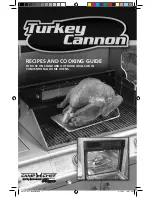
12
LIQUID PROPANE CYLINDER REQUIREMENTS
(20-lb Cylinder)
A dented or rusty Liquid Propane cylinder may be hazardous and should be checked by your supplier. Never
use a cylinder with a damaged valve. The Liquid Propane cylinder must be constructed and marked in
accordance with the specifications for Liquid Propane cylinders by the United States Department of
Transportation (DOT) or the National Standard of Canada, CAN/CSA-B339, Cylinders, Spheres and Tubes for
Transportation of Dangerous Goods Commission.
The 20-lb cylinder must have a shut off valve terminating in a valve outlet specified, as applicable, for
connection type QCC1 in the standard for compressed gas cylinder valve outlet and inlet connection
ANSI/CGA-V-1.
Storage of an outdoor cooking gas appliance indoor is permissible only if the cylinder is disconnected and
removed from the outdoor cooking gas appliance. The cylinder system must be arranged for vapor withdrawal.
The cylinder must include a collar to protect the cylinder valve.
Manifold pressure: (operating) 10 inches water column (W.C.), (non-operating) 11.2 inches water column
(W.C.).
The Liquid Propane cylinder must be fitted with an Overfill Protection Device (OPD).
Remove the plastic valve cover from the Liquid Propane cylinder. Make sure the grill gas hoses do not contact
the grease pan or grill firebox when the Liquid Propane cylinder is placed into the cart.
CONNECTING THE LIQUID PROPANE CYLINDER
Your grill is equipped with gas supply orifices for use with only Liquid Propane gas. It is also equipped with a
high capacity hose/regulator assembly for connection to a standard 20-lb Liquid Propane cylinder (18-1/4
inches high, 12-1/4 inches diameter).
To connect the Liquid Propane gas supply cylinder:
1. The cylinder valve should be in the “OFF” position. If not, turn the valve clockwise until it stops.
2. Make sure the cylinder valve has the proper type-1 external male thread connections per ANSI Z21.81.
3. Make sure the burner valves are in the “OFF” position.
4. Inspect the valve connections, port and regulator assembly. Remove debris and inspect the hose for
damage.
5. When connecting the regulator assembly to the valve, use your hand to tighten the nut clockwise until it
stops. Use of a wrench could damage the quick coupling nut and result in a hazardous situation
6. Open the cylinder valve fully by turning the valve counterclockwise.
7. Before lighting the grill, use a soap and water solution to check all the connections for leaks.
8. If a leak is found, turn the cylinder valve “OFF” and do not use the grill until a local Liquid Propane dealer
can make repairs.
WARNING
Never attempt to use damaged or obstructed equipment. See your local Liquid Propane dealer for repair.
DISCONNECTING THE LIQUID PROPANE CYLINDER
1. Turn the grill burner valves “OFF” and make sure the grill is cool.
2. Turn the Liquid Propane cylinder valve “OFF” by turning clockwise until it stops.
3. Detach the regulator assembly from the cylinder valve by turning the quick coupling nut counterclockwise.
4. Place dust cap on cylinder valve outlet whenever the cylinder is not in use. Only install the type of dust cap
on the cylinder valve outlet that is provided with the cylinder valve. Other types of caps or plugs may result
in leakage of propane.
Figure 325
CSA International
Project 2070363
13 of 31













































